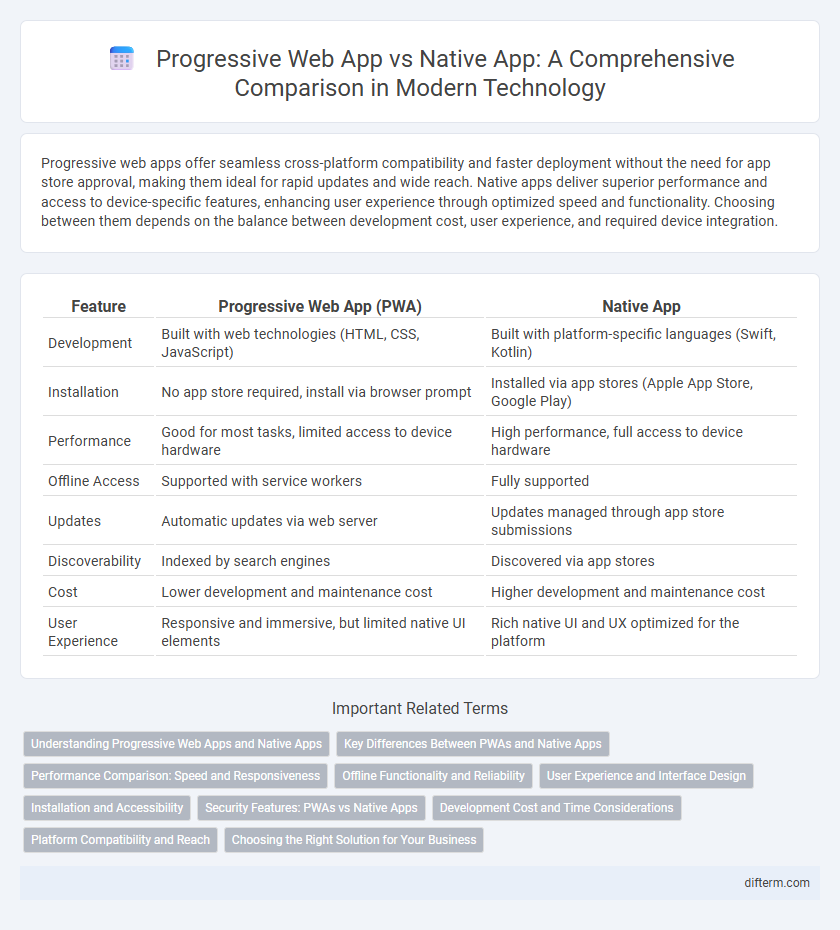Progressive web apps offer seamless cross-platform compatibility and faster deployment without the need for app store approval, making them ideal for rapid updates and wide reach. Native apps deliver superior performance and access to device-specific features, enhancing user experience through optimized speed and functionality. Choosing between them depends on the balance between development cost, user experience, and required device integration.
Table of Comparison
| Feature | Progressive Web App (PWA) | Native App |
|---|---|---|
| Development | Built with web technologies (HTML, CSS, JavaScript) | Built with platform-specific languages (Swift, Kotlin) |
| Installation | No app store required, install via browser prompt | Installed via app stores (Apple App Store, Google Play) |
| Performance | Good for most tasks, limited access to device hardware | High performance, full access to device hardware |
| Offline Access | Supported with service workers | Fully supported |
| Updates | Automatic updates via web server | Updates managed through app store submissions |
| Discoverability | Indexed by search engines | Discovered via app stores |
| Cost | Lower development and maintenance cost | Higher development and maintenance cost |
| User Experience | Responsive and immersive, but limited native UI elements | Rich native UI and UX optimized for the platform |
Understanding Progressive Web Apps and Native Apps
Progressive Web Apps (PWAs) leverage web technologies such as HTML, CSS, and JavaScript to deliver app-like experiences directly through browsers, offering cross-platform compatibility without installation. Native apps are built using platform-specific languages like Swift for iOS and Kotlin for Android, enabling deeper hardware integration and superior performance. Understanding PWAs highlights their offline capabilities and instant updates, while native apps excel in accessing device features and providing optimized user interactions.
Key Differences Between PWAs and Native Apps
Progressive Web Apps (PWAs) leverage web technologies to deliver app-like experiences directly via browsers, featuring cross-platform compatibility and seamless updates without app store dependency. Native apps, built specifically for platforms like iOS or Android using platform-specific languages such as Swift or Kotlin, offer superior performance and access to device hardware. Key differences include installation methods, offline functionality, and user engagement, where PWAs excel in discoverability while native apps provide deeper integration with system features.
Performance Comparison: Speed and Responsiveness
Native apps generally deliver superior speed and responsiveness due to direct access to device hardware and optimized code execution. Progressive web apps leverage modern web technologies and can approach native app performance but may experience latency in complex tasks or limited offline capabilities. Benchmark tests reveal native apps outperform PWAs by 20-30% in terms of load times and animation smoothness on average.
Offline Functionality and Reliability
Progressive web apps (PWAs) offer offline functionality through service workers, enabling caching of essential content and seamless user experiences even without internet connectivity. Native apps provide more robust offline capabilities by utilizing device storage and system-level APIs, ensuring higher reliability for complex tasks. While PWAs improve accessibility across platforms, native apps remain superior in delivering consistent offline performance and reliability for resource-intensive applications.
User Experience and Interface Design
Progressive Web Apps (PWAs) deliver a seamless user experience by combining web accessibility with app-like interface design, enabling fast loading, offline functionality, and responsive layouts across devices. Native apps offer superior performance and deeper integration with device features, providing highly optimized and intuitive UI tailored specifically for each platform. Choosing between PWAs and native apps depends on balancing cost-effective development and broad compatibility against enhanced responsiveness and customized user interactions.
Installation and Accessibility
Progressive web apps (PWAs) offer seamless installation through web browsers without requiring app store downloads, enhancing accessibility across multiple devices and operating systems. Native apps demand installation via platform-specific stores, such as the Apple App Store or Google Play, which may limit user reach due to platform restrictions. PWAs enable quick access and offline functionality with minimal storage usage, making them highly accessible for diverse user environments.
Security Features: PWAs vs Native Apps
Progressive Web Apps (PWAs) utilize HTTPS to ensure secure data transmission and offer sandboxed environments that limit access to sensitive device features, providing robust protection against common web vulnerabilities. Native apps leverage operating system-level security measures, including biometric authentication, secure storage, and hardware encryption, offering deeper integration and stronger data protection. While PWAs prioritize secure web standards and ease of updates, native apps deliver enhanced security through direct access to device-specific security frameworks and APIs.
Development Cost and Time Considerations
Progressive web apps (PWAs) significantly reduce development cost and time by using a single codebase across multiple platforms, eliminating the need for separate iOS and Android development. Native apps generally require dedicated teams for each platform, increasing expenses and extending development timelines due to platform-specific coding and maintenance. Businesses prioritizing rapid deployment and budget efficiency often prefer PWAs for their streamlined and cost-effective development process.
Platform Compatibility and Reach
Progressive web apps (PWAs) deliver broad platform compatibility by running seamlessly on any device with a modern web browser, including desktops, smartphones, and tablets, without requiring app store installations. Native apps are developed specifically for individual operating systems like iOS or Android, optimizing performance and access to hardware but limiting reach to particular platforms. PWAs enhance user acquisition and retention through wider accessibility, while native apps excel in delivering high-performance features tailored to specific devices.
Choosing the Right Solution for Your Business
Progressive web apps (PWAs) offer cross-platform compatibility, faster development, and lower maintenance costs, making them ideal for businesses seeking broad reach and cost efficiency. Native apps deliver superior performance, access to device-specific features, and enhanced user experience, which is crucial for companies prioritizing high functionality and engagement. Businesses should evaluate their target audience, budget, and performance requirements to determine the optimal app development strategy.
Progressive web app vs Native app Infographic

 difterm.com
difterm.com